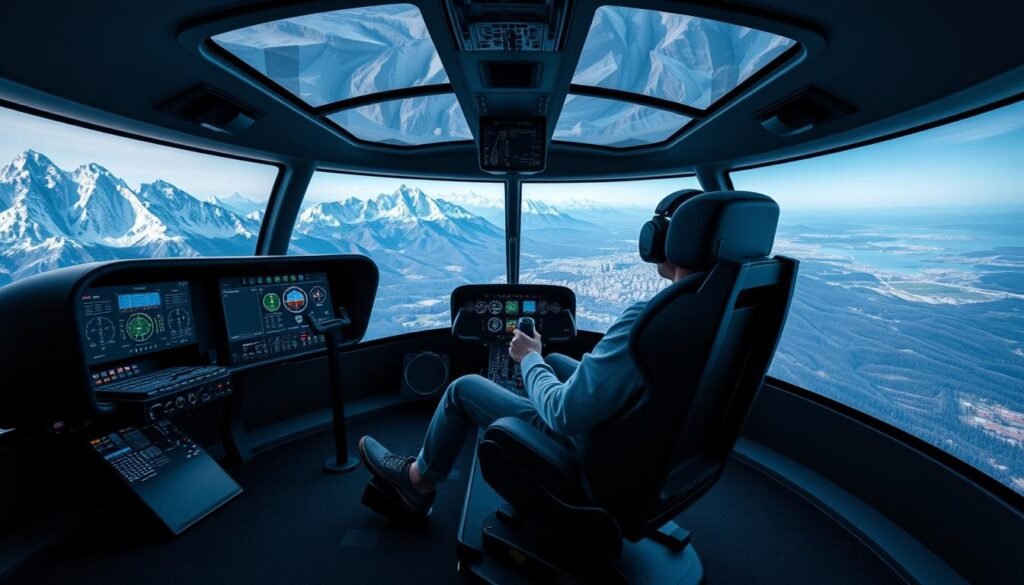One startling fact: total pay can vary from roughly $60,000 to over $200,000 a year depending on role and location.
The guide breaks down what a professional in this field can expect across roles like EMS, corporate transport, offshore work, instruction, and military service.
Readers will learn why pilot-in-command hours, region, and operation type drive offers and insurance minimums.
The piece pulls current U.S. ranges and averages and explains how experience and aircraft type affect base and additional pay.
For detailed role-by-role numbers and benchmarks, see the full breakdown on recent income bands and trends in the industry at this pay breakdown and a stage-by-stage career outlook at career stages guide.
Key Takeaways
- Compensation ranges widely—expect $60k–$200k+ based on role and market.
- EMS, corporate, and offshore roles show different entry and top pay bands.
- Pilot-in-command hours and total flight experience are the main pay drivers.
- Aircraft type and specialized ratings boost market value and offers.
- Location and demand shape total compensation and cost-of-living impacts.
Helicopter Pilot Salary Overview In The United States
Recent U.S. compensation reports reveal a broad spread in earnings tied to role type, region, and flight hours.
Current Pay Ranges And Averages From Leading Compensation Sources
National benchmarks for 2024 place the average base near $106,617, with a common range of $90,430–$137,053. Aggregated role data shows private and civilian positions mostly between $90,000 and $112,000, and a civilian average around $100,249 per year.
Entry and training roles differ: flight school instructors often earn about $66,000 per year, while EMS starts near $60,000–$70,000 and top earners can reach roughly $150,000. Some military postings and certain metro markets, like parts of Florida, model total pay above $200,000 when bonuses are included.
Key Factors That Drive Variations In Pay
- PIC Hours & Experience: Higher command hours directly lift offers.
- Operation Type: EMS, offshore, corporate, and instruction carry distinct pay bands.
- Location & Market: Metro demand and regional cost of living change packages.
- Company Practices: Employers structure base versus additional pay differently.
For more detailed benchmarks, see the recent compensation survey and a practical career and earnings overview that breaks down role-by-role totals.
Helicopter Pilot Salary By Role
Compensation varies widely by role, with distinct entry points and top-end pay tied to mission type and experience.

Emergency Medical Services And Air Ambulance Compensation
EMS starts near $60,000–$70,000 and rises with night flying, instrument ratings, and seniority.
Experienced crews in busy systems can approach $150,000 per year.
Law Enforcement And Public Safety Pay Bands
Pay for law enforcement aviation roles depends on municipal budgets and mission needs.
Search and rescue work often adds stipends or overtime for critical incidents.
Offshore Oil And Gas Pilot Earnings
Offshore oil assignments offer top total compensation and can exceed $200,000 with premiums for long rotations and PIC time.
Flight Instructor And Flight School Pathway Salaries
Flight instructor jobs usually pay around $66,000 while pilots build hours for turbine and corporate roles.
Private, Civilian, And Corporate/VIP Transport Pay
Private and corporate roles center near $90,000–$112,000; the civilian average sits around $100,249 per year.
Military Helicopter Pilot Compensation Considerations
Some military assignments push total earnings past $120,000 depending on station, aircraft, and allowances.
| Role | Typical Entry | Common Range | Top-End Notes |
|---|---|---|---|
| EMS / Air Ambulance | $60k–$70k | $70k–$120k | Up to ~$150k with seniority |
| Law Enforcement / Public Safety | $55k–$75k | $65k–$110k | Depends on jurisdiction budget |
| Offshore Oil & Gas | $90k+ | $120k–$180k | Can exceed $200k with premiums |
| Flight Instructor / School | $50k–$66k | $60k–$75k | Common stepping stone to higher pay |
Role choice and certifications shape how quickly a pilot make higher earnings; those aiming to accelerate income should target offshore, corporate, or senior EMS positions once hour minima are met.
For a detailed breakdown of pay by experience and role, see the complete guide at helicopter pilot pay overview.
Regional Pay: Where Helicopter Pilots Earn The Most In The U.S.
Local demand, industry mix, and cost of living create clear pay pockets for professionals across the country.

National Benchmarks And Total Pay Estimates
National averages place base pay near $106,617, with a common range of $90,430–$137,053. Many roles land just above $100k before bonuses or stipends.
High-Paying States And Metro Hubs
States such as California, Texas, and New York often post offers above $100,000 due to dense operations and higher living costs.
Modeled metro totals can top $200,000. For example, Florida estimates show a base near $129,874 and additional pay around $78,753 for a modeled total of ~$208,627.
Cost Of Living, Demand, And Urban Versus Rural Dynamics
High pay often comes with higher housing and commute costs. Rural jobs may pay less but lower expenses can improve net income.
Demand spikes from offshore oil activity or busy EMS systems can push offers up. Companies in major markets may add bonuses, profit sharing, and schedule incentives.
| Region | Base (Median) | Common Range | Notes |
|---|---|---|---|
| National | $106,617 | $90,430–$137,053 | Typical industry benchmark |
| Florida (modeled) | $129,874 | >$200k total with add-ons | High additional pay drives total to ~$208,627 |
| High-Paying States | $100k+ | Varies by metro | CA, TX, NY; corporate & offshore hubs |
For a closer look at regional offers and company practices, see the Air Methods pay study.
Experience, Flight Hours, And Certifications That Boost Pay
A structured approach to time-building and ratings determines how quickly a professional reaches higher pay bands.

Entry-Level Roles And Building Time
Many start as a flight instructor in school programs, earning about $66,000 while logging hours toward 1,000 total flight hours. This phase focuses on disciplined training and consistent time accumulation.
Mid-Career Progression And PIC Milestones
Reaching key PIC hour thresholds in turbine aircraft opens EMS captain seats, corporate transport, and offshore contracts. Employers prize documented command time and mission experience.
Senior Roles And Leadership Compensation
Chief pilot and operations leads combine oversight duties with higher base pay. Management responsibility, safety oversight, and training coordination often justify larger total compensation packages.
High-Value Ratings And Total Compensation
- High-value ratings: instrument, CFII, NVG, mountain ops, external load, turbine transition.
- Total pay mix: cash bonuses, profit sharing, retirement contributions, and schedule differentials.
- Emergency and night work commonly add premiums for on-call time and IFR missions.
“Documented experience and targeted certifications drive faster career movement and better offers.”
Conclusion
This short summary frames the practical way forward for anyone aiming to improve pay and progress in rotorcraft careers.
Key point: U.S. totals commonly center near a $106,617 average base, with clear upside in EMS, offshore, and corporate roles.
Choose the most efficient way to build flight hours, target the aircraft and mission types that pay premiums, and plan ratings that expand opportunity. Many move from instruction into EMS or offshore work as command time grows.
For a deeper look at benchmarks and role strategies, see this detailed salary guide and the highest-paying roles overview.
FAQ
What is the typical pay range for a rotary-wing aviator in the United States?
National compensation varies by role and region. Entry positions often start lower, while experienced crew in offshore or corporate roles earn significantly more. Major sources like the Bureau of Labor Statistics and industry surveys report a wide range reflecting part-time work, overtime, and per-diem arrangements.
Which roles tend to offer the highest earnings?
Highest pay usually appears in offshore oil and gas contracts, VIP and corporate transport, and specialized search and rescue operations. Public safety and medical evacuation crews may also receive premium pay for irregular hours and hazardous missions.
How do flight hours and experience affect compensation?
Time logged directly impacts earning potential. Employers reward PIC hours and turbine time; reaching common milestones opens senior, chief, and contract positions that include better pay and benefits.
What certifications and ratings most increase market value?
Instrument and CFII credentials, night-vision goggle (NVG) proficiencies, external load and mountain flying qualifications, plus turbine/Type-Ratings, consistently command higher pay. Specialized training signals readiness for demanding missions.
How does region influence pay and job availability?
Coastal and energy-industry hubs, plus large metro areas with corporate traffic, show stronger demand and higher compensation. Rural or low-demand regions pay less but may offer faster flight-hour building opportunities.
Are there typical benefits beyond base pay to expect?
Total compensation packages often include per-diem, health insurance, retirement plans, flight and training subsidies, and travel allowances. Some operators add performance bonuses and relocation assistance.
What is a common pathway for someone starting out to increase earnings?
New entrants often work as instructors or in aerial survey roles to build hours. Gaining turbine time, advanced ratings, and specialty missions (EMS, law enforcement support, offshore) accelerates progression to higher-paying posts.
How do law enforcement and EMS roles compare on pay and schedules?
Public safety roles may offer stable government benefits and pensions but sometimes pay less than offshore or corporate positions. EMS positions pay competitively for night and rapid-response duty, with added premiums for medical mission experience.
What should candidates look for when comparing job offers?
Compare hourly or salary figures alongside flight hour guarantees, duty schedules, per-diem, insurance, retirement, training opportunities, and contract length. Consider long-term career path and the operator’s safety record.
How quickly can one move into senior or leadership positions?
Advancement depends on hours, type ratings, leadership experience, and operational knowledge. Many reach supervisory or chief roles after several thousand flight hours and demonstrated crew/resource management skills.
Do military backgrounds affect civilian marketability and earning potential?
Yes. Former military crewmembers often translate tactical and turbine experience into higher starting pay and faster placement into demanding civil roles, especially in offshore, EMS, and specialized contract work.
What training investments yield the best return for career growth?
Prioritize turbine transition, instrument competency, CFII, NVG, and external-load endorsements. These credentials unlock higher-value missions and broaden hiring prospects across industries.
How do contractors and seasonal work impact annual income?
Contract and seasonal jobs can spike annual earnings through higher hourly rates and overtime, but they may lack steady benefits. Pilots should weigh immediate pay versus long-term security when choosing contracts.
Where can reliable compensation data be found?
Credible sources include the Bureau of Labor Statistics, Helicopter Association International, industry salary surveys, and operator job listings. Cross-reference multiple sources to account for regional and role-specific variation.



